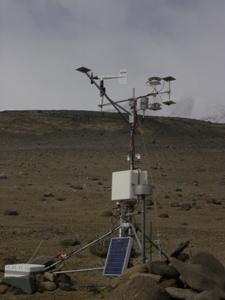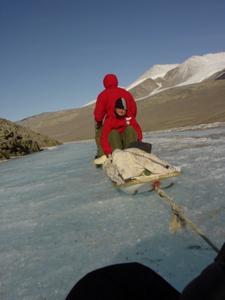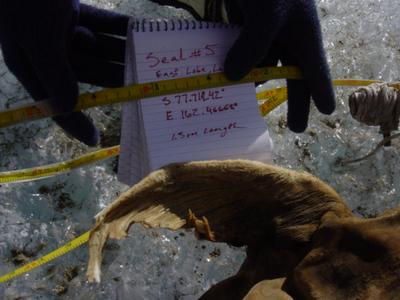22 November, 2003
Hang on tight!
Temperature: 14*F
Location: Lake Bonney, Dry Valleys
We only have a few more days scheduled here at Lake Bonney. Things are running
fairly smoothly, so Peter decided to "divide and conquer" the remaining tasks.
It was decided that Peter and Phil would return to McMurdo Station to build a
couple weather stations which will be deployed next week into the Ponds region
of the Antarctic coast. Roman and I will stay here at camp and finish work on
one of the melt holes and to search for more dead seals on the lake ice here.
Roman and I watched the helicopter depart carrying Peter and Phil away; it was a
bit odd to watch our leader fly off into the distance! Roman and I got right
to work looking for seals. Lake Bonney is a large lake, so to increase our
search ability, we fired up the rickety old snow mobile and attached a "banana
sled" to the back. One of us would drive, the other would ride in the banana
sled with the gear.
The bumpy lake ice made traveling like this an adventure, but we were able to
cover much more ground. We took samples from five more seals on the east lobe
of the lake, then decided it was time to head for the west lobe. Lake Bonney
is split into two lobes connected by a beautiful channel area. Our ultimate
goal was to find and take samples from eight seals on the east lobe and three
from the west lobe.
It was getting late and we needed to also finish melting the hole to free and
reset the monitoring station in the west lobe. We decided to head west, get
our work done in the west lobe, and finish looking for east lobe seals
tomorrow.
We tackled the monitoring station in the west lobe first. We needed to move the
hot finger a bit to finish melting some frozen cable in another area.
Everything seems to take longer than expected in Antarctica. We kept thinking
about ten minutes would finish the melt. Twenty minutes later, it was still
melting! We freed up one more section only to find yet another section still
frozen. We moved the hot finger again. While this was melting, we went
searching for seals. After a while of searching with no luck, we headed back
to the melt hole. It was almost melted, but not quite. Not much longer after
that, the cable was released from it's icy impisonment. We hauled up the cable
and buoy, dragged the anchor back to its proper position below the hole. We
re-lowered all the monitoring cables, set them in their working position and
then checked our work with the underwater cable. With much relief, everything
was just as it should be! The station was ready to collect data for another
season.
Back to seal hunting. We found only one seal in the west lobe. When we collect
samples, we note where the seal was found with GPS coordinates. We also
measure the length of the seal and take photographs both before and after the
sample is collected. In each photo, we hold a sign with the seal number, GPS
information, and a metric measuring tape so the scale is clear. The samples
are snipped with a pair of bone cutting shears and wire cutting pliers. After
each cut, the tools are wiped clean. Prior to cutting another seal, the tools
are soaked in bleach to prevent cross contamination between samples.
At ten pm, we called it a day and made a rapid return to camp. Steering the
decrepid old snow mobile on rough ice and balancing the banana sled are both
challenging tasks - we had to both hold on tight!
All is well and I'm having the time of my life.

1. The weather station at Lake Bonney.

2. Snow mobile with the banana boat in tow.

3. Seal sample number 5.
Contact the TEA in the field at
.
If you cannot connect through your browser, copy the
TEA's e-mail address in the "To:" line of
your favorite e-mail package.
|
